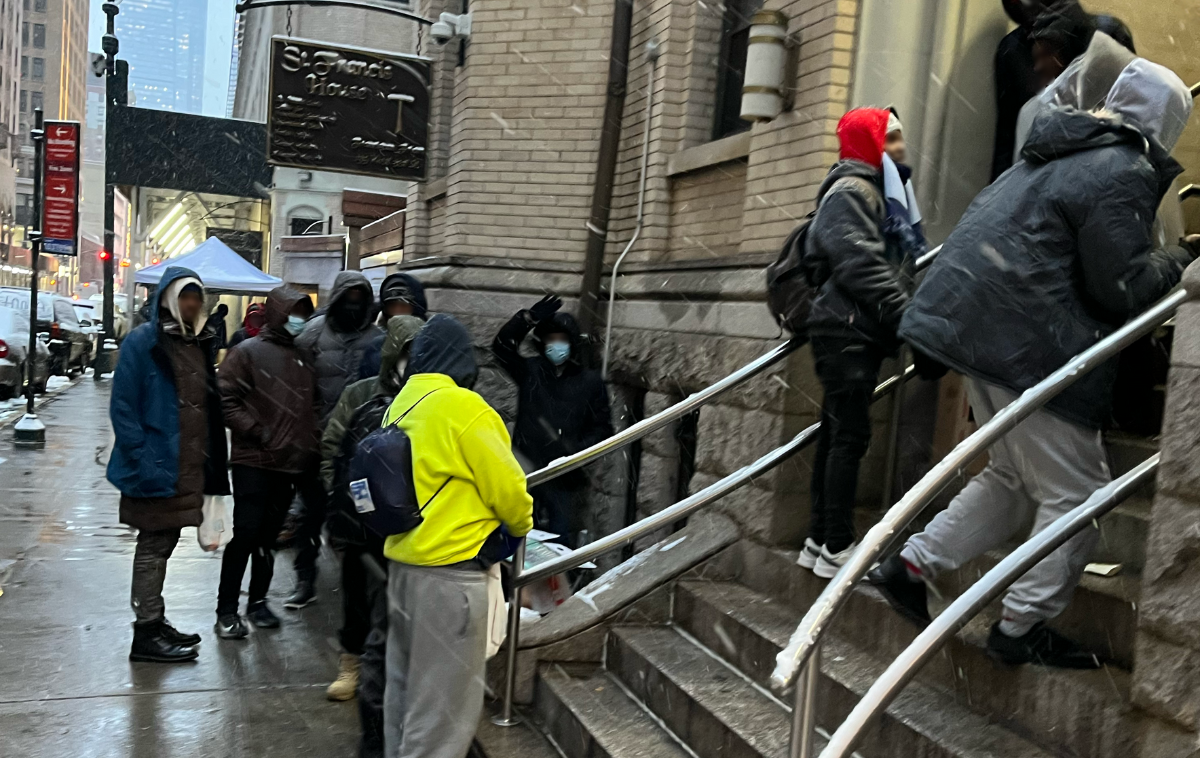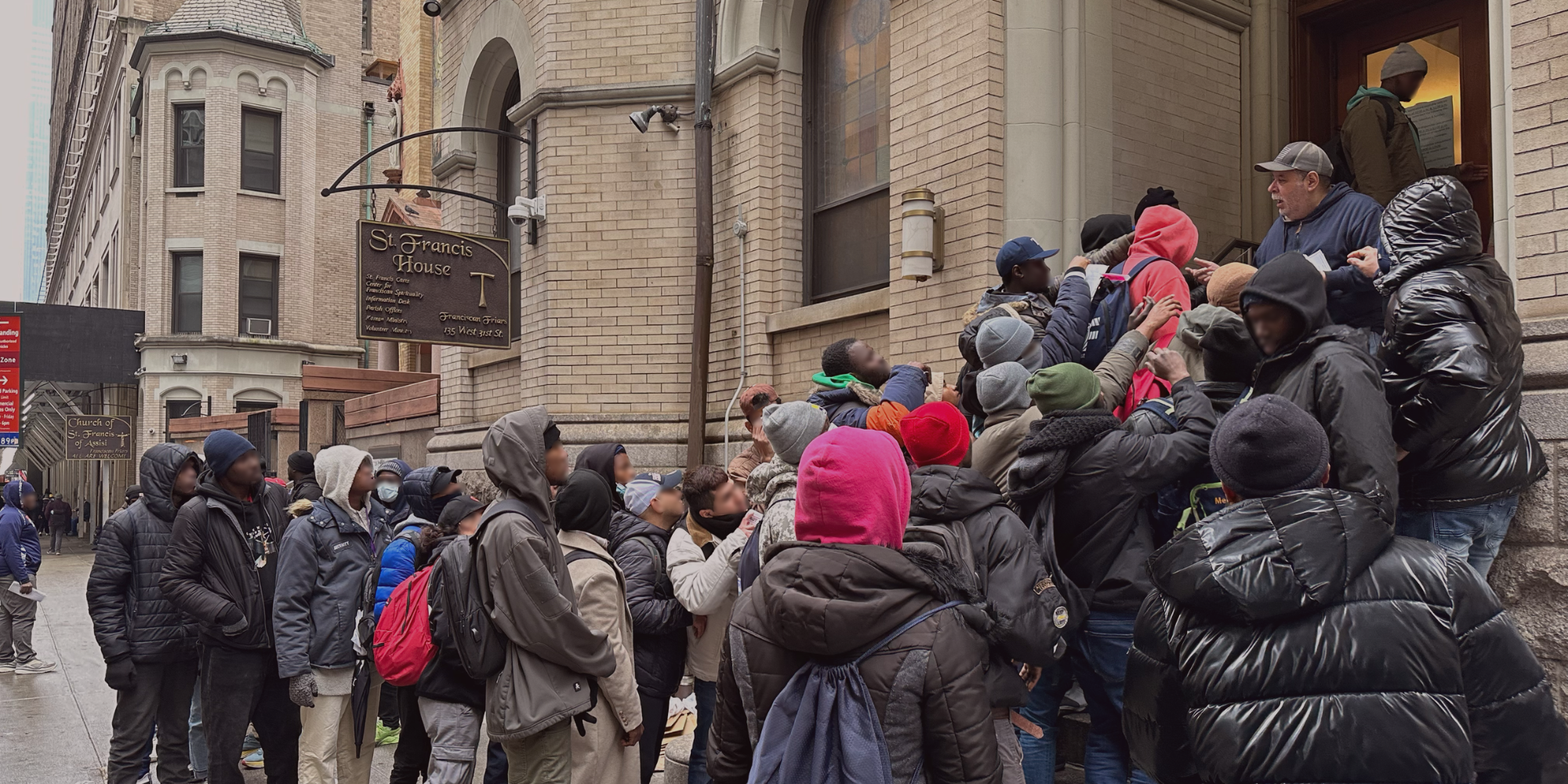A race against time: Friars assist migrants in applying for asylum
Date Published: September 04, 2024
By Maria Hayes
Steps away from the dazzling lights of Broadway theatres and Times Square wandering tourists, a humanitarian crisis was unraveling. Busloads of migrants from Texas began arriving at Manhattan’s Port Authority Bus Terminal on Aug. 5, 2022. People came with nothing but the clothes they wore and a few personal items.
Br. Julian Jagudilla, OFM, listened to news reports with increasing levels of concern. He had been serving immigrants, migrants and refugees in New York City for more than a decade and knew that the city’s immigration landscape was about to change dramatically.
Hundreds of migrants arrived week after week. In one month, New York City’s shelter system — already supporting more than 48,000 unhoused people — was overwhelmed. Emergency tent complexes were created in city parks to manage the overflow. Most migrants arrived wearing flip-flops and shorts, unprepared for sleeping in the cold weather that would arrive in a matter of weeks.
At The Migrant Center at the Church of St. Francis of Assisi in Manhattan, Br. Julian and a team of part-time workers and volunteers began a desperate race against the clock to collect and distribute warm clothing before temperatures dropped.
Responding to a humanitarian crisis
Most people served by the Migrant Center are from countries with warm-weather climates: Venezuela and Colombia (South America), Burkina Faso, Sierra Leone, Guinea and Senegal (Africa), and most Central American countries. Many are fleeing violence, civil unrest and economic hardship, risking their lives on a perilous journey to the United States for the chance to find safety and security.
As migrants began coming to the Church of St. Francis of Assisi seeking warm clothing, Br. Julian and his team put out a call for donations. Funding was a challenge at first, but as the word spread, generous New Yorkers began emptying their closets for the newest members of their city.
Two months after the buses began arriving, The Migrant Center launched a drop-in center that provided supplies three days a week, assisting more than 2,500 families from October 2022 to April 2023.
“A lot of people came forward to help, including people from outside of our parish,” said Br. Julian. “I had volunteers from as far as New Jersey and Long Island. For me, it’s a clear expression of faith in action – people coming to help people in need.”
The crisis continued to grow. Having run out of room in its shelter system, New York City began converting some hotels into shelters for recently arrived migrants. Down the block from the Church of St. Francis of Assisi on West 31st Street, The Stewart Hotel became a 618-room shelter for recently arrived immigrants, bringing the refugee crisis within steps of the Migrant Center’s front door.
Br. Julian reasoned that the drop-in center was a temporary solution to a more pressing need: helping migrants find work so that they could reduce their reliance on government assistance and become self-sufficient.
The power of a work permit
Migrants need work permits to find authorized work. To get a work permit, they must first apply for asylum in the United States.
“The work permit is the only way for them to survive decently in this city. If they are working under the table, they are subject to all sorts of abuse,” Br. Julian said. “I’ve heard stories of someone who worked under someone else’s social security number at an established food chain in the city with a promise of pay. He worked there for seven days and only got paid for one day. He was afraid to file a case because he is undocumented.”
Generally, people can apply for asylum if they are at the United States border, or if they have been in the United States for less than one year (there are some exceptions to this). If someone is granted asylum, they can live and work anywhere in the United States and apply to become a Lawful Permanent Resident (green card holder), among other benefits, according to U.S. Citizenship and Immigration Services.
The asylum application process, however, is complex and begins with a 12-page form that must be completed in English. Once the initial form is submitted, people can request a work permit 150 days (about 5 months) later.
.png?sfvrsn=263f6615_1)
There are thousands of people seeking asylum in New York City and many local agencies have struggled with the sudden influx of requests. At the Church of St. Francis of Assisi, it has become common to see crowds form each time The Migrant Center opens intakes for asylum applications. (Photo courtesy of Br. Julian Jagudilla)
Signs of desperation
In May 2023, The Migrant Center created a program to assist asylum seekers with completing their applications for asylum and for work permits. They help people fill out the complicated forms and mail them to specific courts.
When The Migrant Center announced that it would open its next round of intake in January 2024, people lined up outside of the church the night before, sleeping on the wintry sidewalks. Word about the program had spread and interest had grown. By early morning, 300 people had gathered. When the doors finally opened, a small mob created a stampede of people desperate to get their chance to live and work in the United States legally.
In one year, The Migrant Center has helped more than 900 people file asylum applications and processed more than 2,000 intakes. Their waiting list has more than 1,400 names. Like many New York City-based organizations that serve migrants, the need far outweighs their capacity to serve.
.png?sfvrsn=2ff80c43_1)
More than 207,000 asylum seekers have passed through New York City since August 2022. Hotels like The Stewart (the building to the right of the fire station) have been converted into temporary shelters as local organizations like The Migrant Center at the Church of St. Francis of Assisi seek to alleviate their immediate needs. (Photo courtesy of Br. Julian Jagudilla)
Navigating new shelter rules
Applying for asylum in New York City became more complicated in March 2024. After struggling for two years to accommodate an already overflowing shelter system, the city placed limits on how long people are allowed to stay in shelters: 30 days for single healthy adults and 60 days for people under 23 or families with children.
The new shelter timelines conflict with application timelines. The process for asylum approval or denial takes more than 30 days. Another challenge: responses to applications and work permits are sent by mail.
“The shelters are jam-packed with people. If their mail goes there, it disappears or is stolen,” said Br. Julian. “It takes six months to get a work permit. In the meantime, you have 30 days to live somewhere before you must move on.”
The Migrant Center has begun using the Church of St. Francis of Assisi as a temporary address for asylum seekers waiting to hear the results of their applications. When mail arrives, people receive a text telling them to pick it up.

Many migrants come from warm-weather climates and are not prepared for New York City’s chilly fall nights and cold winters. The Migrant Center has organized clothing drives for people who do not have warm clothing. (Photo courtesy of Br. Julian Jagudilla)
Hope and consolation
These new programs – the drop-in center, the asylum applications, the mail service – were created as The Migrant Center continued to offer its regular services:
— legal assistance at a significantly reduced rate or free, including help applying for a change in immigration status (citizenship, green cards, etc.)
— advocacy for immigrants' rights and comprehensive immigration reform, and
— education through immigration courses and human rights conferences.
Br. Brian Jordan, OFM, established The Migrant Center at the Church of St. Francis of Assisi in the 1990s. After he was reassigned, the center became dormant before Br. Julian revived it in 2013. Today, this outreach ministry of the church serves migrants and refugees with four part-time staff members and about 90 volunteers.
“One thing I tell my volunteers is that you have to be understanding of people’s situations,” said Br. Julian. “Your situation has never been theirs. Be welcoming, be understanding, be hospitable. We’re hoping that migrants come here to find legal assistance, but also hope and consolation.”
The Migrant Center’s work is life-changing.
“Some people think that there is no solution to their situation,” said Br. Julian. “I had a client who hadn't been home in 15, 20 years. We were able to revive his petition, and he got his green card. He went home for the first time and his mother almost fainted. She almost didn’t recognize him.”

In one year, The Migrant Center has helped more than 900 people file asylum applications and processed more than 2,000 intakes. Their waiting list has more than 1,400 names. (Photo courtesy of Br. Julian Jagudilla)
Faith in the American dream
Since August 2022, more than 207,000 asylum seekers have come through New York City. As they arrive, they pass through the shadow of the iconic Statute of Liberty. In her upraised hand is a torch that shines in the darkness. In her pedestal, a poem: “Give me your tired, your poor, your huddled masses yearning to breathe free.”
Just like those who arrived before them, today’s asylum seekers seek safety and hope in a far-reaching humanitarian crisis. Br. Julian has been moved by their spirit in the face of nearly insurmountable odds.
“There are some people who came here without documents. Now they have children, families, and a lawful immigration status. They work here,” said Br. Julian. He pauses for a moment.
“When I think about how they were able to manage and to survive, it’s the power of human determination, coupled with hope and faith,” he adds. “They come here believing ‘I can do this. I can survive in this country and have a family and my own children.’ A bright future – that’s what we call the American dream, right? At the Migrant Center, we are hoping that we are part of their journey to success.”
How to support The Migrant Center
The Migrant Center at the Church of St. Francis of Assisi is located at 135 W. 31st Street, New York, NY 10001. The center is always looking for volunteers, including:
Lawyers, paralegals or legal representatives willing to provide pro-bono legal services or legal consultations
Intake coordinators
Translators
Data entry clerks
Advocates and educators
Donations are also gratefully accepted. For more information or immigration assistance, contact the center at 212-736-8500 x 377 or migrantcenter@stfrancisnyc.org.

How to apply for asylum
The process for applying for and receiving asylum is complex. If you are not able to utilize resources from The Migrant Center, there are other resources available:
— Catholic Legal Immigration Network, Inc. (CLINIC) has a directory of affiliates across the country.
— Catholic Charities provides assistance at locations across the country.
This is the third in a series of articles about Franciscan ministry during the global migration crisis, a humanitarian crisis of vast proportions. The previous article focused on the work friars are doing to assist migrants arriving at the U.S.-Mexico border in El Paso, Texas.

